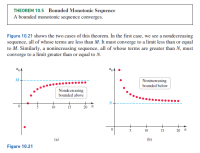
Calculus: Early Transcendentals
8th Edition
ISBN: 9781285741550
Author: James Stewart
Publisher: Cengage Learning
expand_more
expand_more
format_list_bulleted
Concept explainers
Topic Video
Question
The following sequence, defined by a recurrence relation, are monotonic and bounded, and therefore converge by Theorem 10.5.
a. Examine the first three terms of the sequence to determine whether
the sequence is nondecreasing or nonincreasing.
b. Use analytical methods to find the limit of the sequence.
an + 1 = (1)/(2) (an + (2)/(an)); a0 = 2

Transcribed Image Text:THEOREM 10.5 Bounded Monotonic Sequence
A bounded monotonic sequence converges.
Figure 10.21 shows the two cases of this theorem. In the first case, we see a nondecreasing
sequence, all of whose terms are less than M. It must converge to a limit less than or equal
to M. Similarly, a nonincreasing sequence, all of whose terms are greater than N, must
converge to a limit greater than or equal to N.
M
Nonincreasing
bounded below
Nondecreasing
bounded above
15
20
10
15
20 n
(a)
(b)
Figure 10.21
Expert Solution
This question has been solved!
Explore an expertly crafted, step-by-step solution for a thorough understanding of key concepts.
This is a popular solution
Trending nowThis is a popular solution!
Step by stepSolved in 2 steps with 2 images

Knowledge Booster
Learn more about
Need a deep-dive on the concept behind this application? Look no further. Learn more about this topic, calculus and related others by exploring similar questions and additional content below.Similar questions
- According to the Bolzano-Weierstrass theorem, every bounded sequence of real numbers has a subsequence that converges to a real number. True or false: Every bounded sequence of integers has a subsequence that converges to an integer. True Falsearrow_forwardin 2. Find the limit of the sequence or determine that the sequence diverges. e" +3narrow_forward1. Show the sequence an = (n+1)/(n-1) is strictly decreasing and bounded below, and give its limit.arrow_forward
- Show that the infinite sequence 5. an = √ (n2 + 1) − √ (n2 − 1) (n ≥ 1) converges by showing that it is monotone and bounded. You do not need to find the limit of the sequencearrow_forwardSuppose we have a recursive sequence ƒ1, ƒ2, ƒ3, . . .. For the purposes of this problem, it does not matter exactly how the fi are defined, only that they are recursively defined. = i=1 For integer n ≥ 1, let P(n) be the predicate that Σï-1 fi = 2fn+2 − 3. Don't worry about whether this predicate "makes sense"; we haven't defined the fi so you won't be able to "make sense" of the P(n). It's not important for this problem. Consider a proof by induction that Vn ≥ 1: P(n). Suppose we've gotten to the inductive step, and suppose that the first steps of the inductive step are k+1 k+1 Σ1 fi = f1 + f2 + Σh fi = f₁ + f2 + Σkt k+1, i=3 (fi−1 + fi−2) = f₁ + f2 + ¹ fi- 1 + k fi 2 f1 k+1 k+1 k = f1 + f2 + Σh_2 fi + [h=1² fi i=2 = f2 + Σ²²₁ fi+fi i=1 i=1 True or false: Based on the information given, we will need strong induction for this proof. True Falsearrow_forward
arrow_back_ios
arrow_forward_ios
Recommended textbooks for you
 Calculus: Early TranscendentalsCalculusISBN:9781285741550Author:James StewartPublisher:Cengage Learning
Calculus: Early TranscendentalsCalculusISBN:9781285741550Author:James StewartPublisher:Cengage Learning Thomas' Calculus (14th Edition)CalculusISBN:9780134438986Author:Joel R. Hass, Christopher E. Heil, Maurice D. WeirPublisher:PEARSON
Thomas' Calculus (14th Edition)CalculusISBN:9780134438986Author:Joel R. Hass, Christopher E. Heil, Maurice D. WeirPublisher:PEARSON Calculus: Early Transcendentals (3rd Edition)CalculusISBN:9780134763644Author:William L. Briggs, Lyle Cochran, Bernard Gillett, Eric SchulzPublisher:PEARSON
Calculus: Early Transcendentals (3rd Edition)CalculusISBN:9780134763644Author:William L. Briggs, Lyle Cochran, Bernard Gillett, Eric SchulzPublisher:PEARSON Calculus: Early TranscendentalsCalculusISBN:9781319050740Author:Jon Rogawski, Colin Adams, Robert FranzosaPublisher:W. H. Freeman
Calculus: Early TranscendentalsCalculusISBN:9781319050740Author:Jon Rogawski, Colin Adams, Robert FranzosaPublisher:W. H. Freeman
 Calculus: Early Transcendental FunctionsCalculusISBN:9781337552516Author:Ron Larson, Bruce H. EdwardsPublisher:Cengage Learning
Calculus: Early Transcendental FunctionsCalculusISBN:9781337552516Author:Ron Larson, Bruce H. EdwardsPublisher:Cengage Learning

Calculus: Early Transcendentals
Calculus
ISBN:9781285741550
Author:James Stewart
Publisher:Cengage Learning

Thomas' Calculus (14th Edition)
Calculus
ISBN:9780134438986
Author:Joel R. Hass, Christopher E. Heil, Maurice D. Weir
Publisher:PEARSON

Calculus: Early Transcendentals (3rd Edition)
Calculus
ISBN:9780134763644
Author:William L. Briggs, Lyle Cochran, Bernard Gillett, Eric Schulz
Publisher:PEARSON

Calculus: Early Transcendentals
Calculus
ISBN:9781319050740
Author:Jon Rogawski, Colin Adams, Robert Franzosa
Publisher:W. H. Freeman


Calculus: Early Transcendental Functions
Calculus
ISBN:9781337552516
Author:Ron Larson, Bruce H. Edwards
Publisher:Cengage Learning